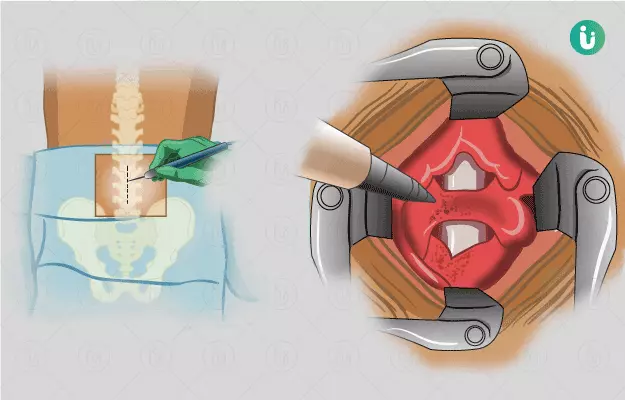Summary
Laminectomy is a surgery performed to remove the lamina (plates of bones on the posterior part of the spinal column) to alleviate the pressure on the spinal cord, which may have been caused by an injury, infection, tumour, or other bone conditions of the spinal column. Before the surgery, the doctor may perform some blood tests and imaging tests. The surgery is usually performed under anaesthesia and can take about 1 to 3 hours. You may need to stay in the hospital for up to 3 days. However, recovery may take longer, about 6 months to 1 year. You may have to visit the surgeon for follow-up 2 to 3 weeks after surgery for the removal of sutures or staples.
- What is laminectomy?
- Why is laminectomy recommended?
- Who can and cannot get a laminectomy?
- What preparations are needed before laminectomy?
- How is laminectomy done?
- How to care for yourself after a laminectomy?
- What are the possible complications/risks of laminectomy?
- When to follow up with your doctor after a laminectomy?
What is laminectomy?
Laminectomy is carried out to remove a part of the vertebral bone in the spine (backbone), known as the lamina.
The spine consists of a stack of about 24 bones (vertebrae), each separated by intervertebral discs that prevent the bones from grinding together and act as shock absorbers. These bones are arranged one above the other and create a vertical tube called the spinal canal. The spinal canal encloses the spinal cord, made of nervous tissue and nerves that transmit signals between the brain and the body. The posterior part of the spinal canal is made of plates of bones called the lamina that provides support and protection to the spinal cord from the back.
A laminectomy is performed to reduce pressure on the spinal cord or nerves or to remove ruptured or bulged out intervertebral disc or tumours. Some of the conditions that can put pressure on your spinal cord include:
- Wear and tear of the bones in the spine
- Injury to the spine
- Certain bone diseases such as spinal stenosis (narrowing of the spaces in the spinal column)
- Infection
- Spinal tumour
- Abnormal alignment of the spine
A laminectomy may be performed along with other procedures such as:
- Discectomy (a surgery to remove the whole or a part of the intervertebral disc)
- Foraminotomy (a surgery performed if you have foraminal stenosis, a condition that puts pressure on the spinal nerves by narrowing the opening from which the spinal nerves exit the spinal cord)
- Spinal fusion (a surgery to fuse two or more vertebrae to restore spinal stability)
Why is laminectomy recommended?
The doctor may recommend this surgery to people with the following symptoms:
Who can and cannot get a laminectomy?
People with the following conditions can get the surgery:
- Spinal canal stenosis (a condition that causes narrowing of the spinal canal) that does not respond to other treatments
- Spinal cord tumours, both primary (tumours that have originated in the spinal cord) and secondary (tumours that have spread to the spinal cord from another location)
- Infections in the spine
- Trauma that fractures the spinal canal Read more: Spinal fracture treatment
The surgery is not recommended in individuals with the following conditions:
- Spinal instability (abnormal movement between the vertebrae)
- Severe scoliosis (abnormal curving of the backbone)
- Degenerative spondylolisthesis (a condition wherein a vertebra slips out of its place; caused by wear and tear of the intervertebral disc as a person ages)
- Isthmic spondylolisthesis (a condition wherein a vertebra slips out of its place due to small breaks in the bone)
- Severe kyphosis (a condition that causes abnormal and excessive curving of the upper back)
What preparations are needed before laminectomy?
Your healthcare provider may perform a physical exam and ask you to get blood tests and the following imaging tests done before the surgery:
- Spinal X-rays
- Computerised tomography (CT) scan
- Myelogram
- Magnetic resonance imaging (MRI) scan
You may be asked to discontinue taking blood thinners (medicines to prevent blood clots), such as naproxen, aspirin, and ibuprofen 1 week before the surgery. Stopping or changing the intake of blood thinners like warfarin, apixaban, clopidogrel, dabigatran, and rivaroxaban should only be done after consultation with your doctor.
Before the surgery, inform your healthcare provider if:
- You are taking any medicines, including prescribed and non-prescribed drugs and herbal supplements.
- You are allergic to tape, latex, certain medicines including anaesthesia medicines
- You are or may be pregnant
- You have a medical history of bleeding disorders (a condition that affects the blood clotting process, such as haemophilia A, haemophilia B)
- You have been drinking alcohol in excess
- You smoke (it may slow down your healing after the surgery)
- You have or get flu, cold, fever, or other illnesses
If you have heart diseases, diabetes, and other medical conditions, the surgeon may ask you to consult with your regular doctor before the surgery
You may be asked to visit a physical therapist before the surgery to learn some exercises and practise using crutches. Arrange for a friend or a family member to accompany you home after the surgery.
You may need to fast for 6 to 12 hours before the operation. Take the medicines told by the doctor with a small quantity of water.
How is laminectomy done?
You will be asked to wear a hospital gown. The surgery requires the administration of general anaesthesia (medicines that put you into sleep) or spinal anaesthesia (you will be awake but will not feel anything below the waist).
This surgery typically involves the following steps:
- The doctor will make you lie on your stomach or side on the operating table (a table where a patient lies during the operation).
- You will be given an injection to make you feel drowsy followed by the administration of general anaesthesia.
- The medical staff will insert a urinary catheter into your bladder, commonly through your urethra (the canal that brings urine out of the body). The catheter will drain urine out of your body till you can do so yourself.
- Next, the surgeon will clean the surgical site using an antiseptic solution and make a cut in the middle of your back or neck. Any extra hairs on the incision site will be removed before cleaning the skin and making the cut.
- After this, he/she will pull aside the muscles and tissues under the skin of the area and will remove a part or all of the lamina in the affected bone. Any bony growths or disc fragments may also be removed.
- Additional procedures like foraminotomy and spinal fusion may be performed at this stage.
- When all is done, the surgeon will place back all your tissues and muscles, and close your skin with stitches or surgical staples.
- Finally, the area will be covered by a sterile bandage or dressing.
The whole procedure can take 1 to 3 hours. You may have to stay in the hospital for 1 to 3 days.
After the surgery
After the surgery, you will be shifted to a recovery room and then to a hospital room. Your doctor will monitor your vitals including your pulse and breathing rate and your blood pressure. He/she may also give you painkillers.
If the spinal fusion surgery was not performed along with this surgery, you would be made to walk as soon as the effects of anaesthesia wear off.
How to care for yourself after a laminectomy?
This surgery has a long recovery period. The bones may require 3 to 4 months to heal completely, and healing may continue for at least a year. The bandages usually wear off within 7 to 10 days of surgery, and if they don’t, you can remove them if the surgeon permits. The area of surgery should be checked every day. You should call the surgeon if you see changes in the area of surgery such as redness, swelling, opening up of the wound, or a warm feeling. The surgeon will also prescribe medications for back pain.
Your surgeon may suggest a physical therapist who can teach you how to do the following activities while keeping your back safe:
- Getting up from the bed or chair
- Lifting and carrying objects
- Exercises to keep your back safe and strengthen the back muscles
After returning home from the hospital, you may need to take the following measures to look after yourself during the recovery period:
- Back brace/corset: You may have to wear the corset or back brace while sitting or walking to support your back.
- Smoking: Avoid smoking and using tobacco products as they can slow down the healing process.
- Bathing: Ask your surgeon when you can shower after the surgery. The surgeon may tell you to keep the surgical site dry for up to a week and covered with plastic while having a shower.
- Sleeping: You can sleep in any position that doesn’t cause back pain.
- Sitting: Avoid sitting at the same place for longer than 20 to 30 minutes.
- Walking: Start with short walks for 2 weeks following surgery, and gradually increase your distance.
- Climbing stairs: If you don’t feel pain or discomfort, you may walk up and down the stairs once daily during the first 2 weeks following surgery.
- Sex: Resume your sex life only after consulting with the surgeon.
- Driving and travelling: Avoid driving for at least 2 weeks after the surgery. Even after that, ask your surgeon before you start driving. Long-distance travelling should also be avoided. If such travel is necessary, take a break after every 30 to 45 minutes to stretch yourself.
- Bending: If you want to pick something from the floor, squat down by bending your knees instead of bending at the waist.
- Lifting weight: Avoid carrying or lifting anything heavier than 5 kilograms.
- Other activities: Avoid indulging in strenuous sports activities (e.g., running or swimming) and strenuous household cleaning activities (e.g., vacuum cleaning).
The surgery may be beneficial in:
- Alleviating pain by relieving the pressure on your spinal nerves
- Preventing worsening of weakness and numbness in the affected area such as legs or buttocks
- Improving the range of movements in your back
When to see the doctor?
Call the doctor if you develop any of the following symptoms after surgery:
- Persistent fever over 101oF
- Dizziness
- Chills
- Breathing or swallowing difficulty
- Opening of the wound
- Increased redness, pain, swelling, drainage, pimples or bumps, or foul odour at the surgical site
- Difficulty urinating
- Loss of bladder or bowel control
- Increased pain and tenderness at the surgical site, chest, abdomen, or shoulder
What are the possible complications/risks of laminectomy?
Some possible complications of this surgery include:
- Infection
- Bleeding
- Nerve damage
- Blood clots
- Leakage of spinal fluid
- Worsening back pain
- Difficulty controlling bladder and bowel movements
When to follow up with your doctor after a laminectomy?
You may visit the doctor 2 to 3 weeks after surgery to remove staples or stitches, and the next appointment would be scheduled after 6 weeks to check your symptoms and healing. The doctor will determine if further follow-ups are required.
Disclaimer: The above information is provided purely from an educational point of view and is in no way a substitute for medical advice by a qualified doctor.
Surgery Cost In Your City
References
- Derman PB, Rihn J, Albert TJ. Surgical management of lumbar spinal stenosis. In: Garfin SR, Eismont FJ, Bell GR, Fischgrund JS, Bono CM, eds. Rothman-Simeone and Herkowitz's: The Spine. 7th ed. Philadelphia, PA: Elsevier; 2018:chap 63.
- Steinmetz MP, Benzel EC, eds. Benzel's Spine Surgery. 4th ed. Philadelphia, PA: Elsevier; 2017:chap 78, 93, 195.
- National Cancer Institute [Internet]. Bethesda (MD): U.S. Department of Health and Human Services; NCI Dictionary of Cancer Terms
- Waxenbaum JA, Futterman B. Anatomy, Back, Intervertebral Discs. [Updated 2018 Dec 13]. In: StatPearls [Internet]. Treasure Island (FL): StatPearls Publishing; 2020 Jan
- Cedars Sinai [Internet]: Cedars Sinai Medical Center. Los Angeles. US; Vertebrae of the Spine
- North American Spine Society [Internet]. Illinois. US; Anatomy of the Spine
- MedlinePlus Medical Encyclopedia [Internet]. US National Library of Medicine. Bethesda. Maryland. USA; Spinal Cord Injuries
- Better health channel. Department of Health and Human Services [internet]. State government of Victoria; Laminectomy
- American Academy of Orthopaedic Surgeons [Internet]. Illinois. US; Herniated disk
- University of Rochester Medical Center [Internet]. Rochester (NY): University of Rochester Medical Center; Spinal Cord Compression
- Mount Sinai [Internet]. Icahn School of Medicine. New York City (NY). U.S.A.; Laminectomy
- Azar FM, Beaty JH, Canale ST, eds. Campbell's Operative Orthopaedics. 13th ed. Philadelphia, PA: Elsevier; 2017:chap 37, 39.
- UFHealth [internet]: University of Florida; Foraminotomy. Gainesville. Florida. US; Foraminotomy
- Estefan M, Camino Willhuber GO. Laminectomy. [Updated 2020 Jan 25]. In: StatPearls [Internet]. Treasure Island (FL): StatPearls Publishing; 2020 Jan
- Sim JE, Noh SJ, Song YJ, Kim HD. Removal of intradural-extramedullary spinal cord tumors with unilateral limited laminectomy. J Korean Neurosurg Soc. 2008;43(5):232–236.
- UW Health: American Family Children's Hospital [Internet]. Madison (WI): University of Wisconsin Hospitals and Clinics Authority; Primary and Secondary Tumors
- Johns Hopkins Medicine [Internet]. The Johns Hopkins University, The Johns Hopkins Hospital, and Johns Hopkins Health System; Laminectomy
- Hall JE. Hemostasis and blood coagulation. In: Hall JE, ed. Guyton and Hall Textbook of Medical Physiology. 13th ed. Philadelphia, PA: Elsevier; 2016:chap 37.
- Goldman L, Schafer AI, eds. Goldman-Cecil Medicine. 25th ed. Philadelphia, PA: Elsevier Saunders; 2016:chap 173, 174.
- Gailani D, Wheeler AP, Neff AT. Rare coagulation factor deficiencies. In: Hoffman R, Benz EJ, Silberstein LE, et al, eds. Hematology: Basic Principles and Practice. 7th ed. Philadelphia, PA: Elsevier; 2018:chap 137.
- Tailly T, Denstedt JD. Fundamentals of urinary tract drainage. In: Wein AJ, Kavoussi LR, Partin AW, Peters CA, eds. Campbell-Walsh Urology. 11th ed. Philadelphia, PA: Elsevier; 2016:chap 6.
- Sabharwal S. Spinal cord injury (lumbosacral). In: Frontera WR, Silver JK, Rizzo TD, eds. Essentials of Physical Medicine and Rehabilitation. 4th ed. Philadelphia, PA: Elsevier; 2019:chap 158.















